

o f the upper one presented a vaulted gallery with big arches grouped in two
The covering of the parvis was of a «by-gable» type: an individual spatial
unit with its own gable roof corresponded to each section o f the cathedral
walls. The no rth part o f the parvis was walled off and had small windows
instead o f arches. On the north-west corner there once was a small clock-
chambe r reached by a narrow stone staircase. The outer wall o f the chamber
pro truded slightly supported by stone consoles which have survived to our
day. A vertical shaft was made in the body o f the wall beside the staircase to
receive the weights of the clock which were lowered in to it.
The aspect o f the cathedral was strongly altered later. First the chapel of
St. Martin ian was attached to its south wall then its windows were hewn
wider, a four-slope roof covered the tiers of «kokoshniki» and the drum was
surmoun ted by a pretentious baroque cupola. The vaults o f the parvis and
the summit o f its walls together with the c lock-chamber were destroyed, its
sou thern part was transformed into a vestry. The original form o f the win
dow openings was restored during restoration works conducted in the begin
ning o f this century.
The cathedral o f Ferapontov monastery has become world-famous be
cause it had retained murals by the renowned Dionysius. The fame o f this
master had been great. He was called an «elegant and wise» icon pain ter, his
icons like the works of Andrei Rublev became collector's items already in
the beginning of the XVI century, they were specially no ted in monastery
inventories.
The fact that the Ferapontov murals were painted by Dionysius is sup
ported by an ancient inscription which has survived above the north door of
the cathedral, it ends in the following words «and the painters were Diony
sius and his children. Oh Lord Christ, Tzar to all, spare them , Oh Lord,
eternal suffering». Such a signature of a master is the rarest phenomenon of
Russian painting of that time, it demonstrates the great self-awareness of
the artist. The «children» of Dionysius mentioned in the inscrip tion were
his sons Theodosius and Vladimir. Other works by Vladimir have not reached
us, we know o f them only from a few mentions in inventories. Theodosius
on the o ther hand was one o f the leading masters of the first th ird o f the
XVI century. In 1508 his artel painted the Moscow Kremlin Annuciation
cathedral o f the grand princes. Theodosius was also the au tho r o f the splen
did gospel miniatures of 1507 from the Public Library.
Art historians had more than once attempted to distinguish the hand of
each o f the three Ferapontov masters. However,
110
one cou ld solve this
task. The opinion was that this problem was absolutely insoluble and that
the three masters worked on every composition together, braking up the
process into individual operations. The striking unity of style characteristic
o f the painting was thus explained. Recent technical and technological anal
yses provided fresh data which probably brings us nearer to the solving of
this problem. A difference in the choice of pigments and painting devices is
revealed in different places in the cathedral. The remarkable speed o f execu
58















